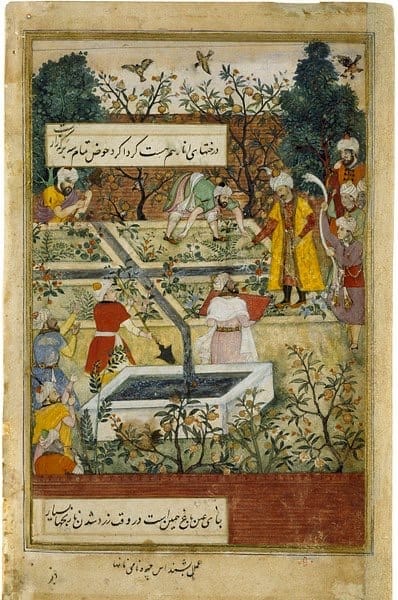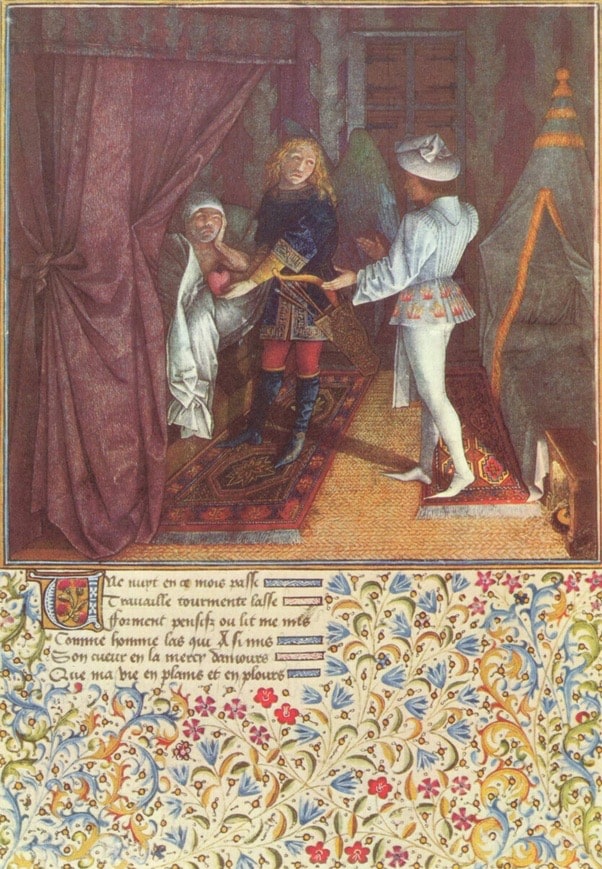Paisley is a genuinely global motif that survived many years, passing through various cultures, evolving into many shapes, names, and colors. The credit for this goes to the endless love of this motif from the tastemakers worldwide. This article traces the origin, movement, evolution, and beauty of this antique motif, which is still a design identity of fashion and home companies from ‘Etro’ in Italy to ‘Kashmir Loom’ in India.
(more…)

Bābur supervising the laying out of his Charbagh The Garden of Fidelity. Opaque watercolor and gold on paper
India – ca.1590
Artists: Bishndas and Nanha From the V&A
Mughal Floral Designs – South Asian art has always been full of floral images, but this reached its zenith in the Mughal empire. During the 330 years that the dynasty ruled, most magnificent art, architecture, and craft that the world has seen were produced, and much imagery used was from flora, particularly in the reigns of Jahāngīr and Shah Jahan. However, Bābur, Humayun, and Akbar are all recorded as profoundly interested in gardens and flowers. One of Babur’s first actions in India was to make a garden, the Charbagh.
The popularity of floral motifs in Mughal art was because traditionally, living creatures and humans were not supposed to be depicted in Islamic art. Therefore, the plant kingdom provided subjects that were non-controversial and capable of stylization.
(more…)
Textiles of Africa 
A Kuba chief in formal attire. Note the cut pile border. Image from The Worldwide History of Dress.
Textiles of Africa occupy a unique spot in the history of world textiles: Their use ranges from clothing, tent awnings, wall hangings, and bed covers: they also indicate the wealth of the owner, and in many cases, his social standing and possessions. Historically, textiles in Africa have also been used as currency. Therefore it is a pity that most western perception of this genre centers on its ‘craft.’ Of course, African textiles are craft-based, but they are so much more than that.
Africa is a massive continent, with immense cultural and geographical diversity, so the only way to examine its textile traditions in such an article is to divide the elements under heads: (more…)

In 1785 Christophe-Philippe Oberkampf invented the first machine for printing wallpaper, later printing on cotton fabric at his factory in Jouy-en-Josas, hence the prints were known as Toile de Jouy
The term ‘Toile de Jouy’ (meaning, “cloth from Jouy”) refers to the printed cotton produced by the Oberkampf textile manufactory at Jouy en Josas in Normandy from 1760 to 1843. It is most often associated with a Rococo pattern of Shepherds and shepherdesses encircled with floral garlands, usually in blue or pink, on a white background. The term is generic and encompasses a wide range of designs from Neoclassical to more generalized floral patterns.
(more…)
 It was usual for the Rajasthan medieval elites to have musicians, artists, and craftsmen associated with their family. The artists were attached to their patron’s family. They would create a whole gamut of objects and arts in-house for family-like jewelry, clothes, music, bangles or prints, etc. Sanganer became a land of great artists and patronizing families. Whenever the king or the ruler needed something particular, word of mouth would search for unique skillsets. The best artisans would be found and sent. The selected printers and dyers would prepare a new design or a new shade of color for their king. And that’s how the skills of the artisans of Sanganer became known and sought by higher nobility.
It was usual for the Rajasthan medieval elites to have musicians, artists, and craftsmen associated with their family. The artists were attached to their patron’s family. They would create a whole gamut of objects and arts in-house for family-like jewelry, clothes, music, bangles or prints, etc. Sanganer became a land of great artists and patronizing families. Whenever the king or the ruler needed something particular, word of mouth would search for unique skillsets. The best artisans would be found and sent. The selected printers and dyers would prepare a new design or a new shade of color for their king. And that’s how the skills of the artisans of Sanganer became known and sought by higher nobility.






